Here's a status report for those interested in our fan M13 project.
We've settled on Bond (the Kird Ape mechanic of getting a bonus if you control a land type) as our returning mechanic, and finalized the abilities for Bond we've been discussing as follows:
Forest bond: +1/+2 if you control a Forest.
Plains bond: Gains vigilance if you control a Plains.
Island bond: Gains flying if you control an Island.
Swamp bond: Gains intimidate if you control a Swamp.
Mountain bond: Gains haste if you control a Mountain.
As you can see, Forest Bond is an exception within the cycle since it doesn't grant a keyword. We're making a conscious choice to break the "rule of four." (The rule of four is an aesthetics rule for cycles in Magic, where if four elements in a cycle follow a rule, the fifth one must too.) Our options for avoiding that was to have another color grant a power and toughness bonus. For example, Mountain bond or Swamp bond could have granted a +2/+0 bonus or a +2/-1 bonus, and Plains bond could have granted a +0/+3 bonus.
With the system we chose, though, we can have creatures that look like familiar cards turn into something that plays very differently through the influence of another color. I believe one of the major reasons players enjoy multicolor sets is that there are cards on which the ability of colors combine in pleasing ways. These creatures create very different combat situations when their keywords are turned on.
Also, I believe these keywords can evoke some kind of feeling: Haste on a 6/4 or 4/2 creature gives players a thrill when you attack with it, and feels scary when the opponent might cast one. Vigilance on a 4/4 makes you feel safe for players who crave that. Flying on a 2/1 lifelink creature makes it feel nifty and you feel a little reward every time you attack with it.
For players who just want a creature that's good/better than its cost, as well as for players who simply enjoy being rewarded for the lands he or she has in play, there's plenty of that too.
As I wrote in an earlier post, to my mind these size bonuses don't register so much as a reward as a textier way to write what the creature's real size is in a deck of a particular color pair like White-Green, because the condition for the bonus is almost automatically attained. But I'm sure there are other players who will enjoy that feeling that you get when you are receiving an in-game bonus. In any case, I will enjoy the good stats of these creatures and the color-choosing considerations that they create in draft.
There may have been other keyword/bonus assignments that are more suited for max symmetry, but I believe this configuration can appeal to more players because each creature's play style is more pronounced. Out of the ways to use Bond, I am hoping that this is the style that will make players want to play the set the most.
One point which I didn't notice until Jay Treat pointed it out is that each keyword bonus grants a keyword for controlling the land for that keyword's main color, but the creature's color is the secondary or tertiary color for that keyword. For example, Blue is the main color for flying, and Island bond is granted to creatures in White and Black, the second and third for that keyword. Red is the main color for haste, and Mountain bond is granted to creatures in Green and Black, the tertiary colors for haste.
Overall, I think we have some reasonably likable creatures, and the set manages to be a "non-mandatory multicolor" set where you can splash a lot of colors if you want to, but you can also just play normal 2-color decks if you prefer that instead.
In testing, it didn't always feel good to sacrifice your deck's consistency in order to splash, so we've added an additional color fixer at common.
(Voyage Chart based on Migration Route by Toby or Not Toby in the Great Designer Search 2)
We also upgraded a land-changing creature to be more main-deckable so that it can be used for multicolor decks. (It used to be a 1-drop 1/1)
We've added Invoker lands to the set.
Jay Treat suggested this idea to put bonuses like the Rise of the Eldrazi Invokers on lands. These lands serve many functions in the set. First of all, we want players to splash lands to turn on Bond, and since these lands have basic land types and have highly splashable abilities, they will be a big incentive for playing off-color lands.
Secondly, these lands would also create an incentive for players to play land destruction spells. As I mentioned in an earlier post, we'll have clunky late-game land destruction spells in the vein of Into the Maw of Hell so that players can interact with Bond by destroying the splash lands that are activating Bond, whether those splash lands are basic lands or these Invoker lands. Bond can be more dramatic if it can sometimes be turned off and then turned on again later in the game.
Finally, the Invoker lands allow aggro decks to push through defense in the very late game, so that games aren't decided after a control decks stabilizes on the board.
Unfortunately, we haven't had time to test this. The last week was full of intense and productive online discussion about what cards should make the final cut. We collectively went through the skeleton shaping process that I described in my previous posts. This weekend is our last chance to test this out and see if it isn't horribly broken.
Another thing that should be added over the weekend are big evasive Uncommon creatures. The Uncommon slots often have 1 outstanding large attacking creature per color, in the vein of Serra Angel, Phantasmal Dragon, Sengir Vampire, Cudgel Troll, etc. Sometimes there is a second strong creature, for example Awakener Druid as runner up to Cudgel Troll, or Water Servant as runner up to Air Servant. These cards make the game interesting, as there is variation between the power level of creatures. They are valuable for helping beginners win too, since it's hard to misplay these, and it's easy for the beginners to see the value in these cards. When the cards all have similar value, the game would favor advanced players who can build curve and synergy with their cards.
Our set has many powerful Uncommon creatures, but they are a different type. For example, in the place of Sengir Vampire or Howling Banshee, we've had Keening Banshee. The sizes of these Uncommons are about the same as a Common, but they have powerful card advantage built into it. Many of the other Uncommons also contain some card advantage, often in the form of a removal ability.
What I experienced in many games was that I would start beating down with a good evasive Common creature, but eventually they would all trade off with other creatures or be removed. I had many protracted games. Cards like Keening Banshee or Stone Thrower were killing off the creatures that were forming a racing clock. Some games felt like an endless contest of trading off Common creatures with other common creatures one by one (or trading a Common creature with a Common removal), and it was all about who keeps drawing more fuel without hiccups, or who has the most 2-for-1 spells like Keening Banshee. Then it would end when some huge rare bomb creature hit the board. (I'm exaggerating in order to convey the feeling that I got from the playtests.)
It wasn't like M10, where a long board stall occurs and then the game ends with some bombs, but in contrast I was having protracted games where trades occur for a long time and then the game ends with some bombs. The Commons mostly trade well with each other and have similar power level, so it feels like it's all about the number of them that you draw. This reminded me of the description of all-Common games that are played in Wizards R&D during early playtesting of a set in one of Mark Rosewater's articles about playtesting. There wasn't as much of a decisive factor in those games until the rares enter play.
Then, the late game rare bombs are game-winning unless you have removal. After playing these games, I'm really starting to appreciate the extra layer of texture that these Air Elemental size Uncommon beaters serve in a normal set, adding something that's in between the evenness of the Commons and the bombiness of the Rares. They're not just "I'll trade my flyer with your flyer," but they're also not "remove me in a few turns or lose."
Now, as I mentioned, I'm exaggerating in order to convey the feeling that I got from the playtests. The Commons do have some difference in power levels among themselves, and the evasion creatures sometimes do race well without trading or dying right away. Sometimes one side overpowered the other and it wasn't about grindouts. A lot of interesting things did happen along the way and it wasn't just about endless trades.
However, in earlier playtests, I have playtested a match where I played with M11 cards, substituting only a few of the Common cards with our Bond cards, and that did feel very different from the M13 test. I believe some of it at least comes from the varying power levels of Commons, Uncommons, and Rares. So one goal to pursue during this final weekend is to try to shave the number of "card advantage & removal" Uncommons that aren't completely integral to the set, and put in more big evasive Uncommons that are simply good at attacking.
I hope you enjoyed this. If any readers are interested in joining in playtests on Sunday, May 27, feel free to contact me at goblinartisanchah@gmail.com.
You will need to install a program called OCTGN which can be used to play custom sets online, which requires Windows. Please try downloading, installing, and registering to it in advance. You will also need an e-mail address that you don't mind sharing with other people you've just met. Please tell me what time during Sunday you will be available in your email.

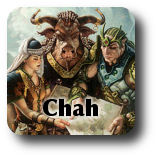
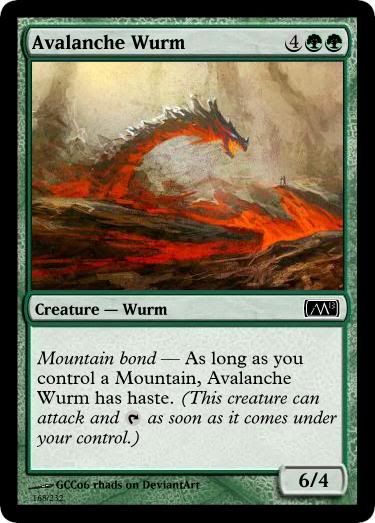
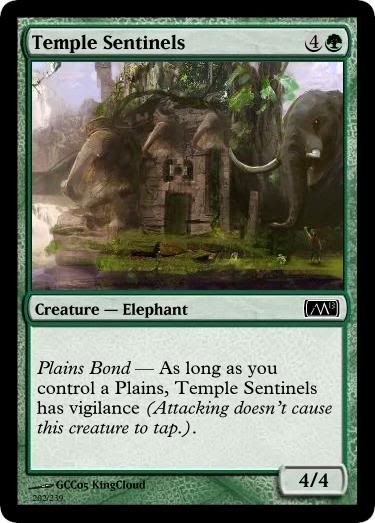

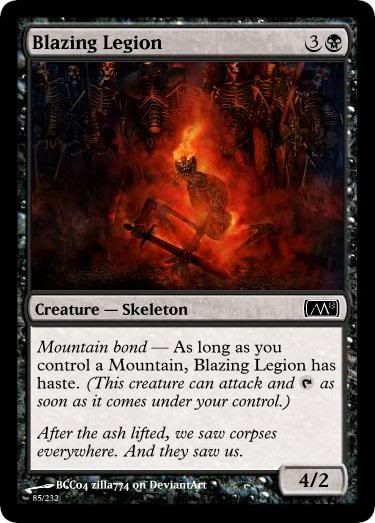

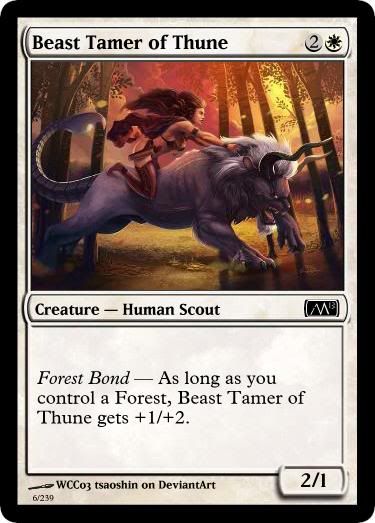



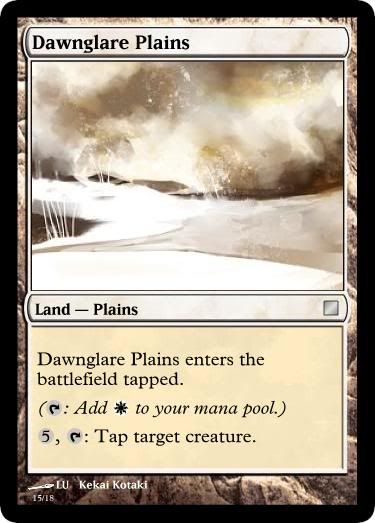

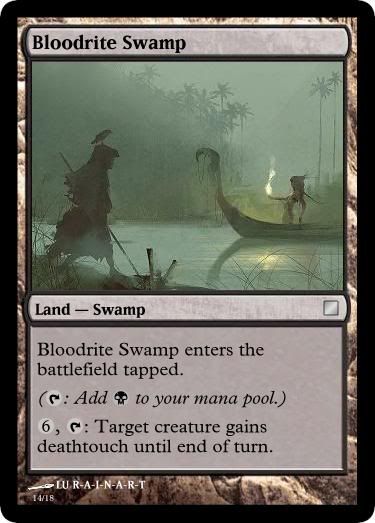
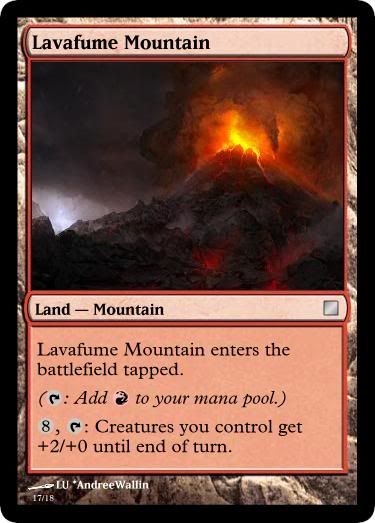



Did you ever try Swamp bond not only giving the creature intimidate, but also turning it black? I wonder if that would be cool; it gains intimidate but black protects itself from its own ability.
ReplyDeleteThat didn't occur to us but we did discuss whether it was too weird that the same ability gave evasion from different colors.
DeleteTurning black from the influence of a Swamp is cool flavorfully. It seems more mechanically balanced if intimidate is spread around the colors, though.